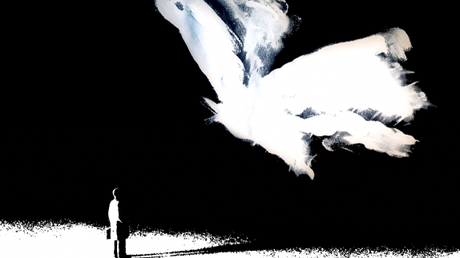by Paul J. Pelkonen

Promotional art for The Echo Drift.
© 2018 The Prototype Festival/International Contemporary Ensemble.
The set was simple: a spartan bed, a stool and a small desk, a cube-shaped prison cell on struts, trapped inside a larger cube that had a projection screen on one side serving as a wall. This assemblage was constructed on a swivel. It and the cyclorama at the back of the stage were the projected surface for minimal scenery rendered in stark white chalk lines. (The set was by co-librettist Elle Kunnos de Voss (credited as "Environment Designer") and the projections were by Simon Harding.)
The occupant of this unlikely space was one Walker Loats, played by mezzo-soprano Blythe Gaissert. Ms. Loats was a prisoner in this infinite space, an inmate serving a life sentence for murder at "the Hersh," a mysterious maximum security prison. Ms. Loats' predicament is the subject of Mikael Karlsson's The Echo Drift, which had its world premiere Wednesday night at Baruch College, as part of the 2018 Prototype Festival.
Mr. Karlsson's opera begins very much in the model of John Adams, a minimalist pulse established with piano, woodwinds and the highest strings on the harp. This bare, skittering introduction brought us to meet Ms. Loats, who manages her time in stir by writing letters to the Governor, constructing, building and repairing a complex do-it-yourself clock and conversing with her new cellmate, a buzzing, flapping moth played by actor John Kelly.
Over the next 70 minutes, the audience was treated to a detailed tour of Ms. Loats' mind, a growing sense of unreality and derangement that owed much to Arnold Schoenberg's Erwartung. Ms. Gaissert read the letters to the Governor, and obsessed repeatedly about connecting, winding and working on the tiny, complex parts of her home-made clock. The Moth went from projected presence to a physical one in the second half of the work. As the tension ratcheted, Mr. Kelly left the orchestra on stage right and joined Ms. Gaissert in the hyper-cube set. And then time stopped.
This is an opera entirely about time, infinite and gray for Ms. Loats, short and crammed with meaning for the Moth. At the work's climax, the Moth persuaded Walker to smash her clock, thus interrupting the recording and passage of measured time and enabling her to enter the titular "Echo Drift", a strange labyrinth of memory and dream where the audience finally learned of her relationship with the Governor, and what tragic events led to her incarceration.
In the central role of Walker Loats, Ms. Gaissert gave a tour de force performance, using her powerful mezzo to great effect despite the unwelcome presence of a pin face mike and unnecessary amplification in the small black box space. Mr. Kelly was an able foil, speaking his responses with a tense urgency that did nothing to dispel the taut atmosphere. In the climax of the opera, he also played the Governor.
Stationed at the left side of the stage, conductor Nicholas DeMaison led the International Contemporary Ensemble(winds, low strings, harp and piano) as the soundtrack for this tale of incarceration and claustrophobia. The music did everything to ratchet the musical texture up to the tightest possible setting. This is a taut, interesting work that should appear on a future bill of chamber operas, and a worthy entry in this year's Prototype Festival.

